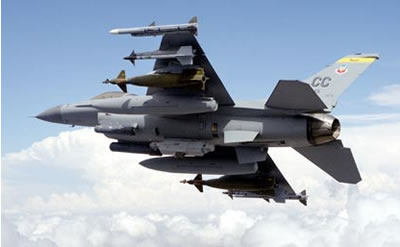
With the United States and many other nations cutting back on their plans to commit money to new aircraft designs while looking to extend the operational life of their existing aircraft, the intensity of international competition in providing weapon’s upgrades has reached new heights in recent months.
BAE Systems, looking for new opportunities to increase revenues, has been quietly challenging Lockheed Martin’s dominance of the international market providing F-16 upgrades. BAE’s moves have not been so quiet as to escape Lockheed Martin’s increasingly concerned attention.
In capturing deals to provide F-16 upgrades for the Turkish Air Force and the US Air National Guard, BAE has placed other international providers on notice that they are a serious contender for lucrative opportunities wherever they may be found. The US Air National Guard deal, providing fire-control upgrades and enhanced Ethernet capabilities for some 270 aircraft, was a major coup and a warning to Lockheed Martin that they should prepare themselves for battle in other markets.
Now, the focus of both companies is on the upgrade offers announced by Taiwan and South Korea. South Korea is looking to sign a $1.6 billion agreement to upgrade 134 RF-16 fighters and Taiwan’s proposal amounts to $4 to $5 billion for upgrades to 146 F-16C/D Block 20 fighters. In addition, Singapore is expected to solicit bids for upgrades to 70 F-16C/D Block 52 aircraft in the near future.
Lockheed Martin has not let BAE’s challenge go unanswered. The company is stressing the fact that they are the original equipment manufacturer (OEM) and are the best choice to provide upgrades for avionics, electrical systems, structural components, and recertification of weapon’s systems.
In the past, Lockheed Martin successfully delivered more than 1,000 upgrade kits to customers worldwide. The company has also been the prime contractor in the integration of Active Electronically Scanned Array (AESA) radars into F-16, F-22, and F-35 aircraft. Historically, once upgrades are completed, the company performing the upgrades becomes the logical choice to incorporate future modifications and enhancements.
In South Korea, the Defense Acquisition Program Administration (DAPA) has responsibility for managing the F-16 upgrade competition. DAPA has accepted bids from BAE and Lockheed Martin and is expected to render a decision sometime in June of this year. Once a contractor is selected, DAPA will then request that the US government negotiate a deal with the winning bidder under the umbrella of the Foreign Military Sales (FMS) Program. In this way, South Korea gains a guarantee of proposed service and hopes the intensity of the competition drives the cost down.
While the United States remains South Korea’s largest arms supplier, DAPA is intensely interested in gaining access to advanced technical knowledge about enhanced avionics and AESA radar manufacture. Such knowledge would be of great value as South Korea continues to pursue plans to develop, in cooperation with foreign allies, an advanced FF-X fighter of its own. Of concern is the restrictive American policy regarding the transfer of technology.
Taiwan’s Ministry of National Defense (MINDEF) is already proving to be somewhat of a headache for BAE. Taiwan has enjoyed a long and comfortable relationship with Lockheed Martin, a relationship the Taiwanese do not wish to jeopardize. MINDEF is also concerned that broader competition might create critical delays that Taiwan can ill afford.
BAE’s answer to the cozy relationship Lockheed Martin enjoys with Taiwan is to do whatever is necessary to force a bidding war that drives the cost down to a level that Lockheed Martin will be unable to match. Also, some members of MINDEF are quite anxious to incorporate an Ethernet option into their aircraft. Lockheed Martin has only recently begun developing such an option while BAE has considerably more experience in this arena.
Only time will tell which company can manage to gain the upper hand and, time is running against BAE at the moment. MINDEF has been specific in their desire to have a Letter of Acceptance (LOA) in hand by May of this year, a deadline that BAE may find difficult to meet.


















